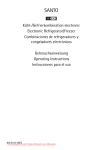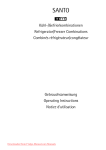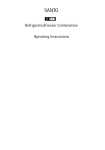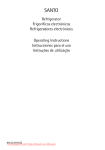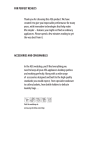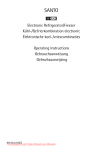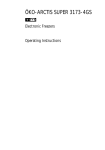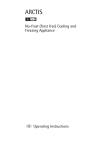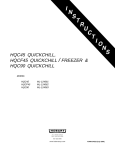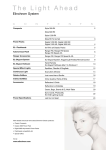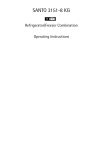Download AEG S 75400 KG Operating instructions
Transcript
SANTO Kühl-/Gefrierkombinationen Refrigerator/Freezer Combinations Gebrauchsanweisung Operating Instructions Downloaded from Fridge-Manual.com Manuals Dear customer, Before placing your new appliance into operation please read these operating instructions carefully. They contain important information for safe use, for installation and for care of the appliance. Please keep these operating instructions for future reference. Pass them on to possible new owners of the appliance. These operating instructions are for use with several technically comparable models with varying accessories. Please observe the notes which apply to your model. 1 Notes which are important for your safety or for the proper functioning of the appliance are stressed with a warning triangle and/or with signal words (Warning!, Caution!, Important!). Please observe the following carefully. 0 1. This symbol and numbered instructions guide you step by step in the operation of the appliance. 2. ..... 3 Supplementary information regarding operation and practical uses of the appliance appear after this symbol. 2 Tips and notes concerning economical and environmentally sound use of the appliance are marked with the cloverleaf. Explanations of the technical terminology used in the operating instructions can be found at the end in the section "Technical Terminology". The operating instructions contain instructions for the correction of possible malfunctions by the user in the section "Something not working". If these instructions should not be sufficient, please contact your local AEG Service Force Centre. Printed on paper manufactured with environmentally sound processes. he who thinks ecologically acts accordingly ... Downloaded from Fridge-Manual.com Manuals 36 Contents Safety . . . . . . . . . . . . . . . . . . . . . . . . . . . . . . . . . . . . . . . . . . . . . . . . . . . . . . . . . 39 Environmental Information . . . . . . . . . . . . . . . . . . . . . . . . . . . . . . . . . . . . . . 42 Packaging . . . . . . . . . . . . . . . . . . . . . . . . . . . . . . . . . . . . . . . . . . . . . . . . . . . . . . 42 Old Appliances . . . . . . . . . . . . . . . . . . . . . . . . . . . . . . . . . . . . . . . . . . . . . . . . . . 42 Appliance Transport . . . . . . . . . . . . . . . . . . . . . . . . . . . . . . . . . . . . . . . . . . . . 43 Before Use . . . . . . . . . . . . . . . . . . . . . . . . . . . . . . . . . . . . . . . . . . . . . . . . . . . . . 43 Packaging . . . . . . . . . . . . . . . . . . . . . . . . . . . . . . . . . . . . . . . . . . . . . . . . . . . . . . 43 Installation . . . . . . . . . . . . . . . . . . . . . . . . . . . . . . . . . . . . . . . . . . . . . . . . . . . . Installation Location . . . . . . . . . . . . . . . . . . . . . . . . . . . . . . . . . . . . . . . . . . . . . The refrigerator/freezer needs ventilation . . . . . . . . . . . . . . . . . . . . . . . . . . . Appliance Alignment . . . . . . . . . . . . . . . . . . . . . . . . . . . . . . . . . . . . . . . . . . . . . Electrical Connection . . . . . . . . . . . . . . . . . . . . . . . . . . . . . . . . . . . . . . . . . . . . 44 44 45 45 46 Reversing The Door . . . . . . . . . . . . . . . . . . . . . . . . . . . . . . . . . . . . . . . . . . . . . 46 Appliance Description . . . . . . . . . . . . . . . . . . . . . . . . . . . . . . . . . . . . . . . . . . . View of Appliance . . . . . . . . . . . . . . . . . . . . . . . . . . . . . . . . . . . . . . . . . . . . . . . No-Frost-System . . . . . . . . . . . . . . . . . . . . . . . . . . . . . . . . . . . . . . . . . . . . . . . . Control Panel . . . . . . . . . . . . . . . . . . . . . . . . . . . . . . . . . . . . . . . . . . . . . . . . . . 49 49 50 50 Prior to Initial Start-Up . . . . . . . . . . . . . . . . . . . . . . . . . . . . . . . . . . . . . . . . . 50 Starting Up and Regulating the Temperature . . . . . . . . . . . . . . . . . . . . . . 51 FROSTMATIC Button . . . . . . . . . . . . . . . . . . . . . . . . . . . . . . . . . . . . . . . . . . . . 52 “Open Door” Warning . . . . . . . . . . . . . . . . . . . . . . . . . . . . . . . . . . . . . . . . . . . 53 Temperature Warning . . . . . . . . . . . . . . . . . . . . . . . . . . . . . . . . . . . . . . . . . . . 53 Switching the Appliance Off . . . . . . . . . . . . . . . . . . . . . . . . . . . . . . . . . . . . . 54 Holiday Mode . . . . . . . . . . . . . . . . . . . . . . . . . . . . . . . . . . . . . . . . . . . . . . . . . . 54 Opening the Freezer Compartment Door . . . . . . . . . . . . . . . . . . . . . . . . . . 54 Downloaded from Fridge-Manual.com Manuals 37 Contents Interior Accessories . . . . . . . . . . . . . . . . . . . . . . . . . . . . . . . . . . . . . . . . . . . . . Storage Shelves . . . . . . . . . . . . . . . . . . . . . . . . . . . . . . . . . . . . . . . . . . . . . . . . . Bottle Rack . . . . . . . . . . . . . . . . . . . . . . . . . . . . . . . . . . . . . . . . . . . . . . . . . . . . . Fruit/Vegetable Drawer . . . . . . . . . . . . . . . . . . . . . . . . . . . . . . . . . . . . . . . . . . . FRESH Box . . . . . . . . . . . . . . . . . . . . . . . . . . . . . . . . . . . . . . . . . . . . . . . . . . . . . Variable Inner Door . . . . . . . . . . . . . . . . . . . . . . . . . . . . . . . . . . . . . . . . . . . . . . Bottle Holder . . . . . . . . . . . . . . . . . . . . . . . . . . . . . . . . . . . . . . . . . . . . . . . . . . . FRUIT-Box . . . . . . . . . . . . . . . . . . . . . . . . . . . . . . . . . . . . . . . . . . . . . . . . . . . . . . 55 55 55 56 56 56 56 56 Correct storage . . . . . . . . . . . . . . . . . . . . . . . . . . . . . . . . . . . . . . . . . . . . . . . . . 57 Freezing . . . . . . . . . . . . . . . . . . . . . . . . . . . . . . . . . . . . . . . . . . . . . . . . . . . . . . . 58 Frozen Storage . . . . . . . . . . . . . . . . . . . . . . . . . . . . . . . . . . . . . . . . . . . . . . . . . 59 Preparation of Ice Cubes . . . . . . . . . . . . . . . . . . . . . . . . . . . . . . . . . . . . . . . . 59 Storage Goods Symbols/Freezing Calendar . . . . . . . . . . . . . . . . . . . . . . . . . 59 Maintenance and Cleaning . . . . . . . . . . . . . . . . . . . . . . . . . . . . . . . . . . . . . . 60 Energy Saving Advice . . . . . . . . . . . . . . . . . . . . . . . . . . . . . . . . . . . . . . . . . . . 61 Something not Working . . . . . . . . . . . . . . . . . . . . . . . . . . . . . . . . . . . . . . . . . 62 Correcting Malfunctions . . . . . . . . . . . . . . . . . . . . . . . . . . . . . . . . . . . . . . . . . . 62 Replace light bulb . . . . . . . . . . . . . . . . . . . . . . . . . . . . . . . . . . . . . . . . . . . . . . . 64 Normal Operating Sounds . . . . . . . . . . . . . . . . . . . . . . . . . . . . . . . . . . . . . . . 65 Regulations, Standards, Guidelines . . . . . . . . . . . . . . . . . . . . . . . . . . . . . . . 65 Technical Terminology . . . . . . . . . . . . . . . . . . . . . . . . . . . . . . . . . . . . . . . . . . 66 Customer Service . . . . . . . . . . . . . . . . . . . . . . . . . . . . . . . . . . . . . . . . . . . . . . . 67 Downloaded from Fridge-Manual.com Manuals 38 1 Safety The safety of our appliances is in accordance with recognised technological standards and appliance safety legislation. We nevertheless feel that it is important to acquaint you with the following safety guidelines: Use for Intended Purpose • The appliance is intended for household use. It is suited for the refrigeration, freezing and frozen storage of foods as well as the preparation of ice. • Alterations or changes to the appliance are not permitted for reasons of safety. • If you use the refrigerator/freezer in a commercial application or for purposes other than the refrigeration, freezing or frozen storage of foods, please observe all valid legal regulations for your application. Prior to initial start-up • Check the refrigerator/freezer for transport damage. Do not under any circumstances connect a damaged appliance! Please contact your supplier in the event of damage. • Make sure that the power plug is not squashed or damaged by the back of the fridge/freezer. A damaged power plug may overheat and cause a fire. • If the power plug socket is loose, do not insert the power plug. There is a risk of electric shock or fire. Refrigerant The refrigerant isobutane (R600a) is contained within the refrigerant circuit of the appliance, a natural gas with a high level of environmental compatibility, which is nevertheless flammable. • Warning - During transportation and installation of the appliance, be certain that none of the components of the refrigerant circuit become damaged. • If the refrigerant circuit should become damaged: – avoid open flames and sources of ignition; – thoroughly ventilate the room in which the appliance is situated. Safety for Children • Packaging materials (e.g. films, styrofoam) can be dangerous for children. Danger of suffocation! Keep packaging materials away from children! Downloaded from Fridge-Manual.com Manuals 39 Safety • Before disposing of old appliances make them inoperable. Remove plug from mains, sever the power cable, remove or destroy any snap or latch closures. This eliminates the danger that playing children lock themselves into the appliance (danger of suffocation!) or place themselves into other life-endangering situations. • Children often do not recognise the dangers involved with household appliances. Please provide for the necessary supervision and do not allow children to play with the appliance! Daily Operation • Containers with flammable gases or fluids can develop leaks through contact with the cold. Danger of explosion! Do not store containers with flammable substances, such as aerosol cans, refill cartridges for cigarette lighters etc. in the refrigerator/freezer. • Bottles and cans may not be placed in the freezer compartment. They can burst when the contents freeze - or even explode if the contents contain carbonic acid! Never place sodas, juices, beer, wine, champagne etc. into the freezer compartment. Exception: Spirits with high alcohol content may be stored in the freezer compartment. • Do not place ice cream or ice cubes directly from the freezer compartment into the mouth. Very cold ice can freeze to the lips or tongue and cause injury. • Never touch frozen goods with wet hands. Hands can freeze to the goods. • Warning - Do not operate any electrical appliances in the appliance (e.g. electric ice cream makers, mixers etc.) unless they have been authorised by the manufacturer. • Warning - In order not to impair the function of the appliance, never cover or obstruct the ventilation openings. • Warning - Do not use any mechanical devices or other artificial means to speed up defrosting unless they are recommended by the manufacturer. • Before cleaning the appliance switch off and remove the plug from the mains, or switch off or turn out the circuit breaker or fuse. • Placing frozen goods on the top of the appliance can lead to the accumulation of condensate in the cavity of the storage tray through contact with the cold. Electronic components are housed within this cavity. If condensate should drip onto these components, the appliance could be damaged by a short circuit. For this reason do not place frozen goods on top of the appliance. Downloaded from Fridge-Manual.com Manuals 40 Safety • Do not remove the power cord by pulling on its lead, particularly when the fridge/freezer is being pulled out of its niche. Damage to the cord may cause a short circuit, fire and/or electric shock. • Do not place heavy articles or the fridge/freezer itself on the power cord. There is a risk of a short circuit and fire. • If the power cord is damaged, it must be replaced by a certified service agent or qualified personnel. In case of malfunction • If a malfunction should occur at the appliance, refer first to the section "What to do if ..." in these operating instruction. If the instructions in this section are not sufficient, do not undertake any further work on your own. • Refrigerators/feezers may only be repaired by trained personnel. Repairs carried out by untrained personnel can lead to substantial danger. Please contact your dealer or our customer service department for repairs. Downloaded from Fridge-Manual.com Manuals 41 Environmental Information Packaging All transit packaging materials are environmentally compatible and can be reused. Wood is un-treated. The plastics can be recycled and are identified as follows: >PE< for polyethylene, e.g. the outer covering and the bags in the interior. >PS< for polystyrene foam, e.g. the pads, which are pure hydrocarbon compounds and can be recycled. The carton parts are made from recycled paper. Please dispose of the packaging with due care for the environment. Old Appliances For environmental reasons, refrigeration appliances must be disposed of properly. This applies to your old appliance, and - at the end of its service life - for your new appliance as well. 1 Warning! Before disposing of old appliances make them inoperable. Remove plug from mains, sever the power cable, remove or destroy any snap or latch closures. This eliminates the danger that playing children lock themselves into the appliance (danger of suffocation!) or place themselves into other life-endangering situations. Disposal: • The appliance may not be disposed of with domestic waste or bulky refuse. • The refrigerant circuit, especially the heat exchanger at the back of the appliance, may not be damaged. • Information concerning collection schedules or locations can be obtained from the local disposal authorities or town hall. Downloaded from Fridge-Manual.com Manuals 42 Appliance Transport Two persons are required for transport of the appliance. There are two recessed handles at the back of the appliance at the top for improved gripping. 0 1. Grip the appliance with the recessed handles positioned as in the drawing, and transport the appliance. 2. In order to push the appliance into its final position, press carefully at the top of the door and tip the appliance back slightly. The weight is thus transferred to the back wheels and the appliance can be easily pushed. Before Use Packaging 0 1. Remove all adhesive tape and packaging from the interior of the appli- ance. 3 Any remnants of adhesive can be removed with white spirit. 2. Remove the transport protection pieces and pull off the adhesive tape. Downloaded from Fridge-Manual.com Manuals 43 Installation Installation Location The appliance should be installed in a well ventilated, dry room. Energy use and efficient performance of the appliance is affected by the ambient temperature. The appliance should therefore – not be exposed to direct sunlight; – not be installed next to radiators, cookers or other sources of heat; – only be installed at a location whose ambient temperature corresponds to the climate classification, for which the appliance is designed. The climate classification can be found on the rating plate, which is located at the left on the inside of the appliance. The following table shows which ambient temperature is correct for each climate classification: Climate classification for an ambient temperature of SN +10 to +32 °C N +16 to +32 °C ST +18 to +38 °C T +18 to +43 °C If installation next to a source of heat is unavoidable, the following minimum clearances must be maintained at the sides of the appliance: – for electric cookers 3 cm; – for oil and coal fired ranges 30 cm. If these clearances cannot be maintained a heat insulating pad is required between the cooker and the refrigeration appliance. Downloaded from Fridge-Manual.com Manuals 44 Installation The refrigerator/freezer needs ventilation Air is fed under the door through the vent slots in the base and is exhausted upwards along the back wall. To ensure proper air circulation never cover or alter the vent openings. Important! If the appliance is installed under a hanging cabinet, a clearance of at least 10 cm between the top of the appliance and the cabinet above it must be maintained. Please check whether, after installing your appliance and especially after reversing the door, the door seal seals tightly. A badly fitting door seal may lead to heavy frosting and a higher power consumption (see also "Something not working“). 0 1. Remove the two wall spacers from the appliance accessories pack and insert them into the heat exchanger bars (condenser) located at the top of the rear of the appliance as per the illustration, so that the distance between the back of the appliance and the wall that is required for correct ventilation is ensured. Appliance Alignment 0 1. The appliance must be level. Please compensate for unevenness in the floor by turning the two adjustable feet at the front. Downloaded from Fridge-Manual.com Manuals 45 Electrical Connection A properly installed socket outlet with earthing contact is required for electrical connection. Electrical fuse protection must be of at least 10 ampere. If the outlet socket is no longer accessible after installation of the appliance, appropriate measures must be taken during electrical installation to assure that the appliance can be disconnected from the mains (e.g. fuse, circuit breaker, non-operate current safety-switch or the like, with a contact opening of at least 3 mm). 0 Before initial start-up, refer to the appliance rating plate to ascertain if supply voltage and current values correspond with those of the mains at the installation location. e.g.: AC 220 ... 240 V 50 Hz or 220 ... 240 V~50 Hz (i.e. 220 to 240 volts alternating current, 50 Hertz) The rating plate is inside the appliance at the left. Warning: To avoid potential danger, if the mains connection lead of this appliance is damaged, it must be replaced by our customer service representative or a person with similar qualifications. Warning: Under no circumstances should the appliance be connected to electronic “power saving plugs” or to a.c.-d.c. converters which convert direct current to 230 V alternating current (e.g., solar installations, ship networks) Reversing The Door The door hinges can be changed from right (as supplied) to left if required to suit the location where the appliance is installed. 1 Warning! Unplug from the mains, before reversing the door. 0 1. Open the freezer door and with- draw the base mask to the front. At the same time, press on the base mask from above. Transfer the door bearing covers on the base mask from left to right. Downloaded from Fridge-Manual.com Manuals 46 Reversing The Door 2. Unscrew the centre door bearing: Open the fridge and freezer doors. Undo the screws far enough to be able to take the top door bearing bolt out of the freezer door. Close the freezer door. Remove the door bearing bolt from the bottom of the fridge door and close the fridge door. Caution! Take care when removing the centre door bearing that the doors do not fall down. Remove the centre door bearing; remove the doors and lay them carefully on the floor. 3. Unscrew the upper and lower door bearing bolts, transfer, and screw them onto the opposite side. 4. Remove the plastic covers for the centre door bearing and insert them on the opposite side. 5. Transfer the self-closing system: Unscrew the self-closing system on the right of the freezer door and screw it onto the opposite side of the freezer door. Unscrew the self-closing system on the right of the fridge door and screw it onto the opposite side of the fridge door. 6. Fit the freezer door into the lower door bearing bolt and insert the centre door bearing above into the freezer door. 7. Insert the fridge door into the upper door bearing bolt. Pull both doors forwards until the centre door bearing can be inserted below into the fridge door. 8. Position the doors and centre door bearing against the housing and screw the centre door bearing tight with each door open. 9. Fit the base mask with the freezer door open. To do this insert the two lower fins of the base mask in the housing and press the basemask against the housing until the upper catches of the basemask snap into position in the housing. To do this, press the catches downwards. Downloaded from Fridge-Manual.com Manuals 47 Reversing The Door After changing the door hinges, check that the magnetic seals on the doors fit perfectly against the housing and that the interior lighting goes off when the door is closed. 10. Depending on the model: Model with bar handle Unscrew the top handle bracket from the handle rod (1). Unscrew the bottom handle bracket from the door (2). Unscrew the top handle bracket from the door (3) and screw onto the bottom right-hand side of the door (4). 1 Caution! Do not overtighten the screws (max. 2 Nm) as you may damage the door handles. Turn the handle bracket with the handle rod 180° and screw them to the door (5) and the fitted handle bracket (6). 1 Caution! Do not overtighten the screws (max. 2 Nm) as you may damage the door handles. Downloaded from Fridge-Manual.com Manuals 48 Appliance Description View of Appliance (various models) á à â ä ã å ç é è ê ë Control Panel Butter and Cheese Compartment with Lid Door Storage Compartments Bottle Compartment/Bottle Rack FRESH Box Fruit/Vegetable Drawer Shelves Freezer Drawer (Maxi Box) Freezer Drawer FRUIT-Box Rating Plate Downloaded from Fridge-Manual.com Manuals 49 No-Frost-System The no-frost-system enables both the freezing of fresh foods and the storage of ready frozen or cooled foods by means of cold air. A vaporiser cools the air in the interior space of the appliance, which is circulated and uniformly distributed by a ventilator. This uniformly circulating air-flow provides for a dry climate, low temperature fluctuations and low temperature differences throughout the appliance's interior space. The moisture in the air condenses as frost on the vaporiser. As soon as is necessary, the vaporiser defrosts fully automatically. The melted water is drained off outside to the compressor and evaporates as a result of the heat generated there. This means that the interior of the appliance and the stored chilled or frozen foodstuffs always remain free of frost and ice. Manual defrosting is not needed. Control Panel 1 2 3 4 5 6 Temperature regulator for the freezer WARNING OFF button (open door warning) (red) WARNING OFF button (temperature warning) (red) FROSTMATIC button (for rapid freezing in the freezer compartment) (yellow) ON/OFF button (green) Temperature regulator for fridge Prior to Initial Start-Up 1 Before connecting the appliance to the mains and putting it into operation for the first time, leave the appliance to stand for 30 minutes if was transported upright. After transport on its side, the appliance must be left to stand for 4 hours before putting it into operation. This is necessary to allow the oil to flow back into the compressor. Otherwise the compressor may be damaged. 0 1. Please clean the appliance interior and all accessories prior to initial start-up (see section: "Maintenance and Cleaning"). Downloaded from Fridge-Manual.com Manuals 50 Starting Up and Regulating the Temperature Fridge and freezer sections can each be regulated independently of the other. The control panel is situated behind the fridge door at the top of the fridge section. 0 1. Insert plug into mains socket. Within 20 seconds the electronics carry out a system test and switch the appliance on. The ON/OFF button lights up in green, the interior lighting comes on and the appliance starts working. If the temperature warning signal sounds, this can be switched off by pressing the ALARM OFF button. 3 Starting up when the appliance is switched off: Press and hold down the ON/OFF button for three seconds. The ON/OFF button lights up in green, the interior lighting comes on and the appliance starts working. If the temperature warning signal sounds, it can be switched off by pressing the ALARM OFF button. Setting the Fridge Temperature 0 1. Open the fridge door. A coin is required to turn the temperature regulator. This makes it more difficult to change the temperature setting accidentally (child safety). Setting “H” = holiday switch Setting “2” = warmest interior temperature Setting “5” = coldest interior temperature 2. Using a coin, set the temperature required for the fridge by turning the temperature regulator. Select a middle position for normal operation. The interior temperature is affected by the ambient temperature, the amount of food in the fridge, and how frequently and for how long the door is opened. 3. Close the fridge door 3 As the storage temperature within the fridge is reached quickly you can store food immediately after switching on. Setting the Freezer Temperature 0 1. Open the fridge door. A coin is required to turn the temperature regulator. This makes it more difficult to change the temperature setting accidentally (child safety). Setting “1” = warmest interior temperature Setting “5” = coldest interior temperature Downloaded from Fridge-Manual.com Manuals 51 2. Using a coin, set the temperature required for the freezer by turning the temperature regulator. Select a middle position for normal operation. 3. Press the FROSTMATIC button. The FROSTMATIC button will be illuminated in yellow and the compressor will operate continuously. 4. To switch off the FROSTMATIC function, press the FROSTMATIC button again. The yellow FROSTMATIC button will go off. 5. Wait until the temperature in the freezer compartment has reached -18 °C before storing frozen foods. 3 Where food hygiene is concerned -18 °C should be considered sufficiently cold for storing food in the freezer. Information: The red warning indicator and temperature warning tone will be activated: – when the freezer is started up (if the storage temperature has not yet been reached) – if the temperature in the freezer compartment is too warm; – if there is a malfunction in the appliance. You can cancel the warning tone with the ALARM OFF button. The warning indicator and warning tone switch off automatically when the temperature in the freezer falls below -10 °C. Such a temperature increase is probably due to: – frequent or extended opening of the door; – storing large quantities of warm food; – high ambient temperature; – a fault in the appliance. FROSTMATIC Button The FROSTMATIC function accelerates the freezing of fresh food and, at the same time, protects foodstuffs already stored from undesirable warming. 0 1. The FROSTMATIC function is switched on by pressing the FROSTMATIC button. The button is illuminated in yellow. The compressor runs continuously. 2. The FROSTMATIC function can be switched off again manually at any time by pressing the FROSTMATIC button again. The yellow illumination in the button will go off. Downloaded from Fridge-Manual.com Manuals 52 If the FROSTMATIC function is not ended manually, the appliance electronics switch off the FROSTMATIC function after 36 hours. The yellow illumination in the button will go off. “Open Door” Warning When the fridge or freezer door are open the open door warning button flashes red and a warning tone is sounded. – after approx. 1 minute if the freezer door is open – after approx. 4 minutes if the fridge door is open If you need more time for inserting frozen or chilled foods or moving them around you can switch off the warning tone by pressing the DOOR OPEN button. The button will stop flashing and will be illuminated in red. The warning tone and the red warning indicator switch off when the doors are closed. Temperature Warning The ALARM OFF button flashes in red and a warning tone sounds as soon as the temperature in the freezer rises above -10 °C. 0 1. You can cancel the warning tone with the ALARM OFF button. The button will stop flashing and will be illuminated in red. 3 The warning tone and the red warning indicator switch off automatically when the temperature in the freezer falls below -10 °C. Such a temperature increase is probably due to: – frequent or extended opening of the door; – storing large quantities of warm food; – high ambient temperature; – a fault in the appliance. Attention! If suspicion of partial or complete thawing exists, please check the quality of the foods to determine if they can be used. If the temperature warning stays on for a longer period please contact AEG Service Force. Downloaded from Fridge-Manual.com Manuals 53 Switching the Appliance Off 0 1. To switch off, hold down the ON/OFF button for approx. 3 seconds. The green illumination in the button will go off. If the appliance is not going to be used for an extended period: 0 1. Switch off the appliance by holding down the ON/OFF button for approx. 3 seconds. The green illumination in the button will go off. 2. Remove the mains plug or switch off. 3. Clean the appliance thoroughly (see section: “Cleaning and Care”). 4. Leave the doors open after defrosting to avoid accumulation of odours. Holiday Mode In the holiday mode the temperature for the refrigerator is approximately between +10 °C and +12 °C. In the holiday mode it is therefore possible to leave the door of the empty refrigerator closed during periods of extended absence. Advantage: Unintentional closing of the door, or accidental closing of the door by persons who have access to your home during your absence, is no longer possible. Without the holiday mode leaving the door closed would lead to the accumulation of odours and mould. After emptying and cleaning the appliance, proceed as follows: 0 1. To switch on the holiday mode, turn the temperature regulator for the fridge to position H. Important! Do not store any foodstuffs in the fridge when the holiday mode is operating. The temperature when the holiday switch is on is regulated to between approximately +10 °C and +12 °C. This is too warm for foods. Opening the Freezer Compartment Door If the freezer compartment door is closed when the appliance is in operation, it is possible that it cannot be immediately opened again. A vacuum occurs in the freezer compartment which holds the door closed until pressure has been equalised. The door can be opened again after several minutes. Downloaded from Fridge-Manual.com Manuals 54 Interior Accessories Storage Shelves The shelf in the lowest runners above the fruit and vegetable drawer is stopped with plastic corners on the back. It must always remain in this position, so that fruit and vegetables stay fresh for longer. To remove the stops, the plastic corners must be twisted 90° forwards and to the outside. The remaining storage shelves can be adjusted to various heights: 0 1. Pull the storage shelf forward until it can be tipped up or down and removed. 2. To insert at a different height use the same procedure in reverse. Bottle Rack Place bottles in the rack with the bottleneck to the front. Important: Only store unopened bottles horizontally. The bottle rack can be tilted for storing opened bottles. 0 1. To do this pull the bottle rack for- ward until it can be tilted upwards, then slide the front support into the next level up. Downloaded from Fridge-Manual.com Manuals 55 Interior Accessories Fruit/Vegetable Drawer (not offered in all models) On some models there is a moisture filter in front of the shelf above the fruit and vegetable compartments. This preserves the natural moisture content of the food in the fruit and vegetable compartments for longer. FRESH Box (not offered in all models) The temperature in the FRESH Box is somewhat lower than in the rest of the fridge. It is therefore especially suitable for storing meat, fish and chilled meals. The FRESH Box can be pulled out, by lifting up the front cover of the box. Variable Inner Door The door compartments can be pulled up and removed, and inserted at other positions as needed. Bottle Holder Some models are equipped with a bottle holder in the bottle compartment. This is used to prevent individual bottles from falling over and can be slid sideways. FRUIT-Box Berries, for example, can be pre-frozen in the FRUIT Box. Advantage: The berries are not squeezed and maintain their natural form. The frozen berries can then be stored in compartments or drawers packaged in individual portions. Downloaded from Fridge-Manual.com Manuals 56 Correct storage The cooling fans ensure an even temperature distribution in the fridge. Foods with different perishability can therefore be arranged on the shelves as you like, without having to take into account the different temperature zones which usually occur. The temperature in the fruit and vegetable drawer is somewhat higher than the fridge temperature set. The example arrangement opposite shows possible ways of storing food. Important! Do not place foods too closely in front of the vents at the rear of the appliance as the foods might freeze. Tip: Food stored in the refrigerator compartment should always be covered or packed so that they do not dry out, lose their flavour, or transfer their flavour to any other refrigerated food. The following are suitable for packing: – polyethylene bags; – plastic containers with lids; – special plastic covers with rubber retainers; – aluminium foil. Downloaded from Fridge-Manual.com Manuals 57 Freezing Warning! • Before foods are frozen, the actual temperature in the freezer compartment must be -18 °C or colder. • Please observe indicated freezing capacity on the rating plate. The freezing capacity represents the maximum amount of fresh goods that can be frozen within 24 hours. If you freeze goods on several days, one after the other, freeze amounts equal to 2/3 to 3/4 of the capacity indicated on the rating plate. • Thawed foods which have not been processed further (cooked into meals) may not under any circumstances be frozen a second time. 0 1. For freezing the maximum capacity press the FROSTMATIC button 24 hours prior to freezing, or 4 to 6 hours for smaller quantities. Yellow indicator lights up. 3 The FROSTMATIC button need not be pressed for freezing of small quantities of up to 3 kg. 2. All foods must be packed air tight prior to freezing, so that they do not dry out or lose their flavour, and so that no flavour contamination of other frozen goods occurs. Caution! Do not touch frozen goods with wet hands. Hands can freeze to the goods. 3. Place packaged goods in the drawers. Unfrozen goods may not come into contact with already frozen goods, otherwise the frozen goods may start to thaw. Tips: • The following are suited for the packaging of frozen goods: – freezer bags and polyethylene wraps; – plastic containers for frozen foods; – extra-thick aluminium foil • The following are suited for sealing bags and wraps: plastic clips, rubber bands or adhesive tape. • Press air out of bags and wraps before sealing, because air encourages drying of frozen goods. • Make flat packages, because these freeze more quickly. • Do not fill plastic containers for frozen foods to the brim with liquid or paste-like goods, because liquids expand during freezing. Note for inspection authorities: Batch plans for the determination of freezing performance or warm-up time can be requested directly from the manufacturer. Downloaded from Fridge-Manual.com Manuals 58 Frozen Storage Warning! Before initial loading of the freezer compartment with previously frozen goods, the required storage temperature of -18 °C must be reached. • Load freezer only with packaged frozen goods, so that they do not dry out or lose their flavour, and so that no flavour contamination of other frozen goods can occur. • Please observe maximum storage times and expiry dates of frozen goods. 2 When possible store frozen goods separately according to type in drawers. Preparation of Ice Cubes 0 1. Fill ice cube tray 3/4 full with cold water and place in the freezer tray or a drawer and allow to freeze. 2. To remove the finished ice cubes twist the ice cube tray or hold under running water for a short time. Warning! Do not, under any circumstances, free an ice tray which is frozen to the appliance with pointed or sharp edged objects. Use a spoon-handle or similar object. Storage Goods Symbols/Freezing Calendar (not included with all models) • The symbols on the drawers show different types of frozen goods. • The numbers indicate storage times in months for the appropriate types of frozen goods. Whether the upper or lower value of the indicated storage time is valid depends on the quality of the foods and pre-treating before freezing. The lower value applies to foods with high fat content. Downloaded from Fridge-Manual.com Manuals 59 Maintenance and Cleaning Before any maintenance or cleaning work is carried out DISCONNECT the appliance from the ELECTRICITY supply. 1 Warning! • Do not use detergents, abrasive powders, highly perfumed cleaning products, wax polishes or cleaning products containing bleach or alcohol. • Never clean the appliance with a steam cleaner. Moisture could accumulate in electrical components, danger of electrical shock! Hot vapours can lead to the damage of plastic parts. • The appliance must be dry before it is placed back into service. Attention! • Ethereal oils and organic solvents can attack plastic parts, e. g. – lemon juice or the juice from orange peals; – butyric acid; – cleansers which contain acetic acid. Do not allow such substances to come into contact with appliance parts. • Do not use any abrasive cleansers. 3 If the refrigerator only is to be cleaned, press the FROSTMATIC button several hours in advance, in order to build up sufficient chill reserve in the freezer compartment for the interruption in service. Do not open the freezer compartment door. 0 1. About 12 hours prior to cleaning push the FROSTMATIC button, in order to build up sufficient chill reserve for the interruption in operation. Caution! Do not touch frozen goods with wet hands. Hands can freeze to the goods. 2. Remove stored and frozen goods, pack them in several layers of newspaper, cover them and store them in a cool place. 3. Switch off refrigerator and freezer and remove plug from the mains, or switch off or turn out the circuit breaker or the fuse. 4. Clean the inside and accessories with warm water and bicarbonate of soda (5 ml to 0.5 litre of water). 5. Rinse and dry thoroughly. 6. Regularly check the door seals and wipe clean to ensure they are clean and free from debris. Downloaded from Fridge-Manual.com Manuals 60 2 Accumulation of dust at the condenser increases energy consumption. For this reason carefully clean the condenser at the back of the appliance once a year with a soft brush or a vacuum cleaner. 7. After everything is dry place appliance back into service. 2 Energy Saving Advice • Do not install the appliance close to sources of heat, such as a boiler, dishwasher or radiator. • Locate the appliance in a cool well ventilated room and make sure that the air openings of the appliance are not obstructed. • Always leave warm food to cool down to room temperature before placing in the freezer. • Try to avoid keeping the door open for long periods or opening the door too frequently as warm air will enter the cabinet and cause the compressor to switch on unnecessarily often. • Ensure there are no obstructions preventing the door from closing properly. • Place frozen goods into the refrigerator for thawing. Cold from frozen goods is thus used for cooling in the refrigerator. • Always keep the condenser at the back of the appliance clean. Downloaded from Fridge-Manual.com Manuals 61 Something not Working Correcting Malfunctions A malfunction may be caused by only a minor fault that you can rectify yourself using the following instructions. Do not perform any other work on the appliance if the following information does not provide assistance in your specific case. 1 Warning! Repairs to refrigerators may only be performed by qualified service engineers. Improper repairs can give rise to significant hazards for the user. If your appliance needs repairing, please contact your specialist dealer or our Customer Service. Symptom Possible Cause Solution Appliance is not switched on. Switch on the appliance. Mains plug is not plugged in or is loose. Insert mains plug. No power to the appliance. Fuse has blown or is defec- Check fuse, replace if tive. necessary. Mains socket is defective. Appliance cools too much. Mains malfunctions are to be corrected by an electrician. Turn the temperature reguTemperature is set too cold. lator to a warmer setting temporarily. Please look in the " TemTemperature is not properly perature Adjustment" secadjusted. tion. The food is too warm. Door was open for an extended period. Open the door only as long as necessary. A large quantity of warm food was placed in the appliance within the last 24 hours. Press the FROSTMATIC button. Turn the temperature regulator to a colder setting temporarily. The appliance is near a heat source. Please look in the "Installation" section. Downloaded from Fridge-Manual.com Manuals 62 Something not Working Symptom Possible Cause Solution The freezer door has been The red warning indicator open for longer than DOOR OPEN is flashing; the 1 minute and/or the fridge warning tone is sounding door has been open for longer than 4 minutes. Switch off the warning tone using the DOOR OPEN button. Do not leave the door open for longer than is necessary. The red warning indicator ALARM OFF is flashing; the Temperature warning warning tone is sounding Please refer to “Temperature Warning” section. All the lamps are flashing and a warning tone is sounding A fault in the appliance Please contact AEG Service Force. Do not open the appliance doors again. Interior illumination does not function. Light bulb is defective. Please refer to "Replace Light Bulb" section. Water in the vegetable drawer Wet vegetables have been stored Throw out the water and store the vegetables again. Steam is developing on the High level of moisture in appliance. the appliance. The compressor does not start immediately after changing the temperature setting or after pressing the FROSTMATIC button. Noise Occurs when foods are stored that have a high moisture content. This does not affect the functioning of the appliance. This is normal, no error has The compressor starts after occurred. a period of time. Appliance is not level. Readjust the front levelling feet. Refer to Normal Operating Sounds If after the above checks there is still a fault, call your local AEG Service Force Centre. In-guarantee customers should ensure that the above checks have been made as the engineer will make a charge if the fault is not a mechanical or electrical breakdown. Please note that proof of purchase is required for in-guarantee service calls. Downloaded from Fridge-Manual.com Manuals 63 Something not Working Replace light bulb 1 Warning! Danger of electrical shock! Before replacing the light bulb switch off the appliance and remove the mains plug. Light bulb specifications (depending on model): 2x Standard 220-240 V, max. 25 W, socket: E 14 or 1x Halogen 220-240 V, max. 25 W, socket: E 14 (Osram Halolux T; clear, product number 64 860 T) 0 1. To switch off the appliance press the ON/OFF button for 3 seconds. The green illumination will go off. 2. Unplug from the mains. 3. To change the light bulb(s), open the plastic cover by pressing the catch back, then fold downwards. 4. Replace faulty light bulb(s). 5. Fold up the light bulb cover and let it click into place. Downloaded from Fridge-Manual.com Manuals 64 Normal Operating Sounds The following noises are characteristic of refrigeration appliances: • Clicks Whenever the compressor switches on or off, a click can be heard. • Humming As soon as the compressor is in operation, you can hear it humming. • Bubbling/Splashing When refrigerant flows into thin tubes, you can hear bubbling or splashing noises. Even after the compressor has been switched off, this noise can be heard for a short time. • Noise When the ventilators are working a noise can be heard. The ventilators ensure better air circulation. Regulations, Standards, Guidelines This appliance was designed for household use and was manufactured in accordance with the appropriate standards. The necessary measures in accordance with appliance safety legislation regulations (GSG), accident prevention regulations for refrigeration appliances (VBG 20) and the regulations of the German Society of Electrical Engineers (VDE) were observed in the manufacture of this appliance. The refrigerant circuit has been checked for leaks. ; This appliance is in accordance with the following EU guidelines: – 73/23/EWG dated 19 February 1973 - low voltage guidelines. – 89/336/EWG dated 3 May 1989 (including guideline change notice 92/31/EWG) - EMV guideline Downloaded from Fridge-Manual.com Manuals 65 Technical Terminology • Refrigerant Liquids that can be used to a generate a cooling effect are known as refrigerants. They have a relatively low boiling-point, indeed so low, that the warmth from the food stored in the fridge or freezer can cause the refrigerant to boil and vaporise. • Refrigerant Circuit Closed circulation system that contains the refrigerant. The refrigerant circuit comprises primarily of an evaporator, a compressor, a condenser and pipe work. • Evaporator The refrigerant is evaporated in the evaporator. Similar to all other liquids, refrigerant requires heat to evaporate. This heat is removed from the interior of the appliance, as a result the interior is cooled. The evaporator is therefore located inside the appliance or placed in foam immediately behind the inner wall and thus not visible. • Compressor The compressor looks like a small drum. It is driven by a built-in electric motor and is mounted on the base of the appliance at the rear. The task of the compressor is to draw in vaporised refrigerant from the evaporator, to compress it, and to pass it on to the condenser. • Condenser The condenser normally has the form of a grid. The refrigerant compressed in the compressor is liquefied in the condenser. During this process, heat is released to the surrounding air at the surface of the condenser. The condenser is mounted on the base of the appliance. Downloaded from Fridge-Manual.com Manuals 66 Customer Service If you cannot find the remedy for a malfunction in these operating instructions, please contact your dealer or our customer service department. Addresses and telephone numbers are listed in the accompanying booklet "Guarantee Conditions/Customer Service Locations". Selective ordering of replacement parts can save unnecessary travel and costs. For this reason always provide the following appliance information: This information can be found on the rating plate in the interior at the • Model Name • Model Number (PNC) • Serial Number (S-No.) left of the appliance. We recommend that you enter this information here, so that it is handy if needed. Note: The customer bears the costs of unjustified customer service calls even during the guarantee period. Downloaded from Fridge-Manual.com Manuals 67 From the Electrolux Group. The world´s No.1 choice. The Electrolux Group is the world´s largest producer of powered appliances for kitchen, cleaning and outdoor use. More than 55 million Electrolux Group products (such as refrigerators, cookers, washing machines, vacuum cleaners, chain saws and lawn mowers) are sold each year to a value of approx. USD 14 billion in more than 150 countries around the world. AEG Hausgeräte GmbH Postfach 1036 D-90327 Nürnberg http://www.aeg.hausgeraete.de © Copyright by AEG 214.3674.01 – 01 - 1203 Änderungen vorbehalten Subject to change without notice Downloaded from Fridge-Manual.com Manuals


































